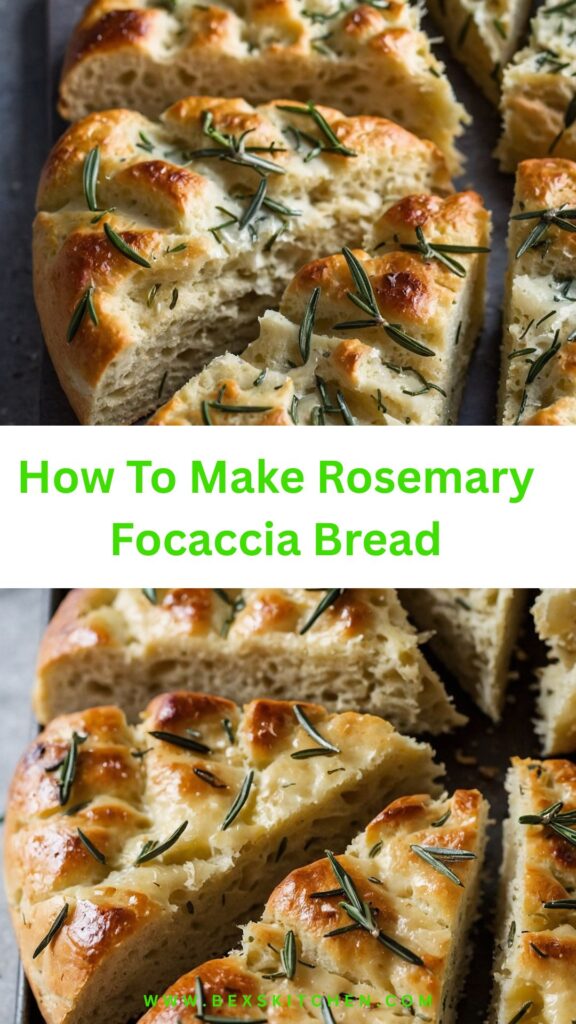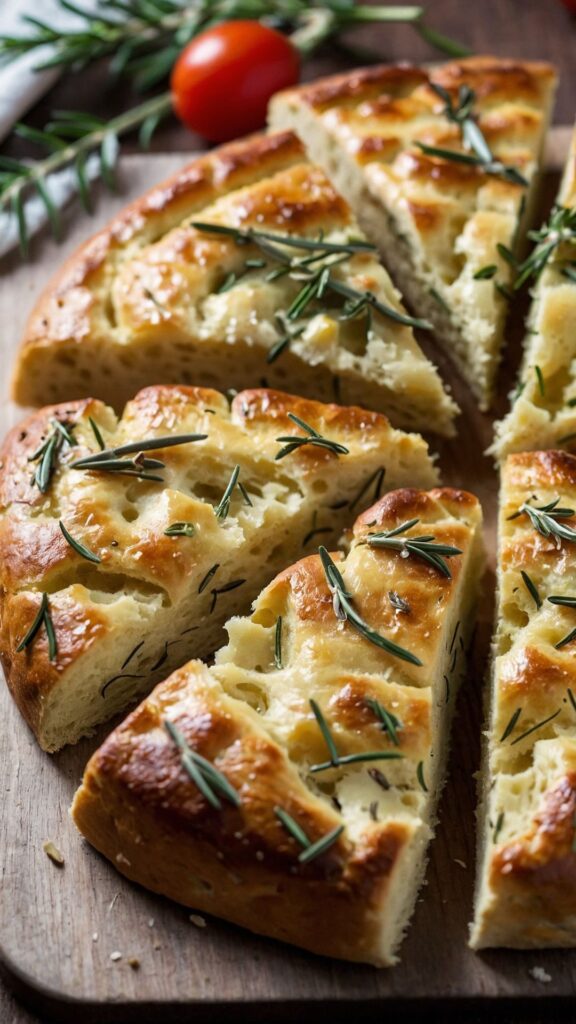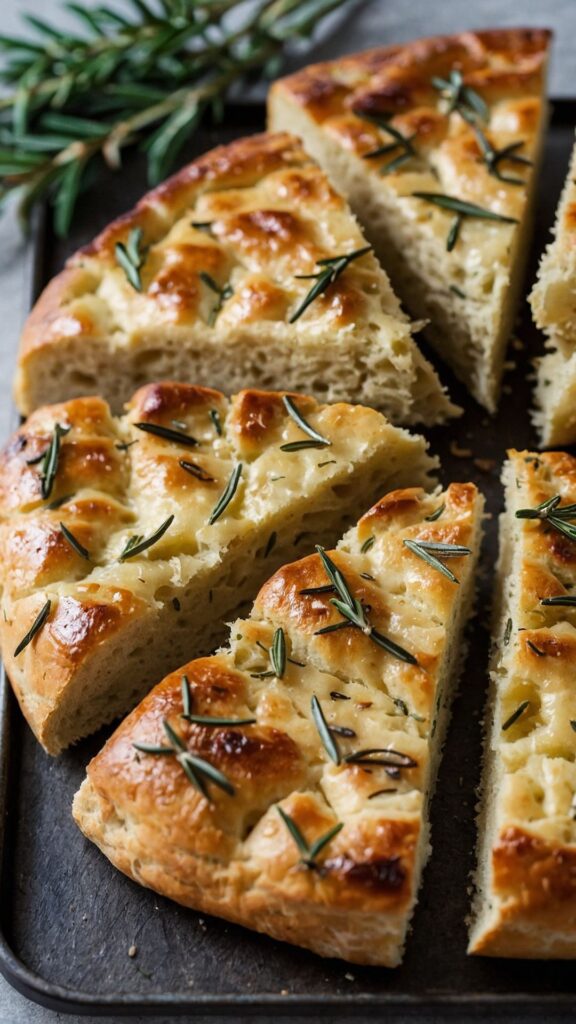Before we dive into the delightful world of rosemary focaccia bread, let’s talk about what you might enjoy it with. Imagine this: a warm, golden piece of focaccia, drizzled with extra virgin olive oil, served alongside a refreshing salad with crisp greens and ripe tomatoes.
Or picture it as the perfect base for a homemade sandwich, dressed with rich cheeses and fresh cured meats. You could even serve it with a hearty bowl of soup, like minestrone or tomato basil, the way the Italians do.
A glass of red wine complements this bread beautifully. Think a bold Chianti or a smooth Merlot. The flavors meld perfectly.
But let’s not neglect the option of enjoying focaccia with a cozy cup of coffee, either. The crunch of the crust and the airy inside make it an excellent afternoon treat.
Now, let’s take a journey into crafting our very own rosemary focaccia bread right in your kitchen.

Rosemary Focaccia Bread
Focaccia bread is an Italian staple that’s beloved across the globe. It’s a simple yet versatile bread, celebrated for its rich, olive-oil-infused flavor and delightful texture. Rosemary, with its pine-like aroma and earthy undertones, ramps up the taste and elevates the experience of every bite.
Creating focaccia bread at home might seem daunting, but trust me—it’s quite the opposite! I still vividly remember the first time I made it.
The gentle kneading, the smell of yeast activating, and ultimately the moment I pulled my golden creation from the oven—you can see why cooking is such a joy! And while it’s true we live in an era of convenience foods, the taste of freshly baked bread is a world apart.
So kick off your shoes, roll up your sleeves, and let’s dive into this culinary adventure together.
You will also like the following Breakfast recipes!
- Panera Chicken Avocado Sandwich
- Copycat Panera Sesame Semolina Bread
- How to make Panera Four Cheese Grilled Cheese
What Is Rosemary Focaccia Bread?
Simply put, focaccia is an Italian flatbread. The dough is rich, thanks to generous amounts of olive oil.
This bread is steered toward flavor, with various toppings ranging from herbs to cheese. Rosemary focaccia specifically highlights fresh rosemary, which gives it that vibrant herbal kick.
You’ll find focaccia in many Italian bakeries. Each variation is unique, crafted with a regional flair using local ingredients. It often embodies the spirit of communal dining—so much so that it’s prone to be shared at gatherings or enjoyed as an accompaniment to meals.
Did You Know? Studies have shown that people gravitate toward dishes with enticing aromas. The aroma of baking bread alone can lift spirits and signal comfort and homeliness—no wonder it’s a favorite in so many homes!
Why You’ll Love Rosemary Focaccia Bread
- Simplicity: The beauty of focaccia lies in its straightforward recipe. It rarely requires complicated techniques. Most of the magic happens during fermentation.
- Texture: The glorious crust combined with a soft inside creates a satisfying bite. Every flavor bursts when paired with olive oil or balsamic vinegar.
- Versatility: You can serve it in a multitude of ways—sectioned into shape for sandwiches, topped with garlic and herbs, or simply enjoyed with butter.
- Homemade Bliss: Nothing beats the satisfaction of baking your own bread. The pride in your creation comes with every loaf you share with family and friends.
- Nutritional Benefits: Compared to store-bought options laden with preservatives, homemade focaccia is free of additives. You control the ingredients, ensuring the highest quality.
The Ingredients You Will Need to Make Rosemary Focaccia Bread
To whip up a fantastic rosemary focaccia, you’ll need the following:
- 3 1/2 cups unbleached all-purpose flour
- 1 packet active dry yeast
- 1 1/3 cups lukewarm water (approximately 110°F)
- 2 teaspoons raw honey or natural sugar
- 1/4 cup cold-pressed extra virgin olive oil, plus additional for drizzling
- 2 teaspoons coarse sea salt flakes, plus extra for sprinkling
- 1 teaspoon finely grated lemon zest
- 1/2 teaspoon garlic powder
- 2 fresh rosemary sprigs

Directions to Make Rosemary Focaccia Bread
Step 1: Prepare the Dough
Start by combining the lukewarm water, honey, and yeast in a medium bowl. Let it sit for about 5-10 minutes until it foams. This is a sign that your yeast is happy and ready to rise.
While that’s happening, sift the flour and combine it with salt in a large bowl.
Step 2: Combine Ingredients
Once your yeast mixture is foamy, create a well in the center of the flour mixture. Pour the yeast mixture and olive oil into this well. Use your hands or a wooden spoon to mix until a sticky dough forms.
Step 3: Knead the Dough
Transfer the sticky dough onto a lightly floured surface. Knead it for about 8-10 minutes until it becomes smooth and elastic. If the dough is too sticky, you can sprinkle a little more flour.
Step 4: First Rise
Lightly oil a large bowl and place your dough inside, turning it to coat. Cover it with a damp kitchen towel or plastic wrap. Allow the dough to rise in a warm place until it doubles in size—this could take about 1-2 hours.
Step 5: Shape the Dough
Once your dough has risen, punch it down to remove excess air. Transfer it to a greased baking sheet or a large cast-iron skillet, gently stretching it to fit the pan. Use your fingers to poke dimples all over the surface.
Step 6: Second Rise
Cover it again and let it rest for another 30-45 minutes. This will enhance the fluffiness of your focaccia.
Step 7: Preheat and Prepare
Preheat your oven to 425°F (220°C). While that’s heating up, drizzle olive oil over the surface of the dough. Sprinkle garlic powder, lemon zest, and rosemary on top. Finish with a generous sprinkle of coarse sea salt.
Step 8: Bake
Place the focaccia in the preheated oven and bake for about 20-25 minutes, or until it’s golden brown. As the aroma fills your kitchen, take a moment to appreciate the anticipation.
Step 9: Cool and Serve
Remove from the oven and let it cool on a wire rack for about 10 minutes before slicing. Enjoy it warm or at room temperature!
Notes: Tips for Perfect Focaccia
- Host a Bread Baking Day: Gather your family or friends to share the fun of baking together. It can turn into a lively and engaging activity.
- Experiment with Toppings: Don’t just stop at rosemary. Consider adding olives, sun-dried tomatoes, or even cheese to mix things up.
- Water Temperature Matters: Ensure your water is lukewarm. If it’s too cool, the yeast won’t activate; too hot, and the yeast can die.
- Storage Techniques: Keep leftovers in an airtight container, or wrap it well in foil for freshness.
- Rise Time is Key: Allow the dough ample time to rise. If you’re in a hurry, place it in a warm spot, like an oven preheated briefly and turned off, to speed up the process.
Storage Tips
Proper storage ensures your focaccia stays delicious. If making ahead, let it cool completely, then wrap it tightly in plastic wrap or foil. Store it at room temperature for a couple of days, or place it in the fridge for up to a week.
For longer storage, consider freezing it. Place it in a freezer-safe bag after it has cooled, and it can last for up to three months. Just be sure to thaw it before consuming and then warm it in the oven for that fresh-baked taste.
Nutrition Information
How To Make Rosemary Focaccia Bread Recipe Nutrition Facts
Serving Suggestions
To make the most of your rosemary focaccia, think outside the box. Here are some suggestions:
- As a Side Dish to Soups: Pair it with a hearty minestrone or classic tomato soup. The bread’s textured crust makes it perfect for dipping or dunking.
- Gourmet Sandwich Base: Transform it into a sandwich using turkey, arugula, and a smear of pesto. Add layers for flavor explosion.
- With Charcuterie Boards: Include slices on a charcuterie board for gatherings. Guests can pair it with cheeses and meats, enhancing the experience.
- Salad Companion: Serve alongside a fresh salad with a balsamic vinaigrette. It adds a satisfying crunch while soaking up the dressing.
- Appetizer Delight: Cut it into small pieces for an appetizer. Dip it in flavored olive oil or balsamic vinegar for an elegant touch.

What Other Substitutes Can I Use in Rosemary Focaccia Bread?
If rosemary isn’t your thing, or you want to try something different, consider these alternatives:
- Oregano: This herb offers a more traditional Italian flavor and works beautifully. Use it fresh or dried for a punch.
- Thyme: Fresh or dried thyme gives an earthy depth to focaccia, distinct and aromatic. This can change the whole flavor profile.
- Sundried Tomatoes: Incorporate finely chopped sundried tomatoes for color and taste. This adds moisture and a somewhat sweet note.
- Cheese: Grated parmesan or Gruyère can be sprinkled atop before baking. It will melt down, adding a savory flavor.
- Zaatar Spice: Try zaatar for a Middle Eastern twist. This blend includes thyme, sesame, and sumac, giving an exciting flavor flip.

Equipment
- oven
Ingredients
- 3 1/2 cups unbleached all-purpose flour
- 1 packet active dry yeast
- 1 1/3 cups lukewarm water approximately 110°F
- 2 teaspoons raw honey or natural sugar
- 1/4 cup cold-pressed extra virgin olive oil plus additional for drizzling
- 2 teaspoons coarse sea salt flakes plus extra for sprinkling
- 1 teaspoon finely grated lemon zest
- 1/2 teaspoon garlic powder
- 2 fresh rosemary sprigs
Instructions
Step 1: Prepare the Dough
- Start by combining the lukewarm water, honey, and yeast in a medium bowl. Let it sit for about 5-10 minutes until it foams. This is a sign that your yeast is happy and ready to rise.
- While that’s happening, sift the flour and combine it with salt in a large bowl.
Step 2: Combine Ingredients
- Once your yeast mixture is foamy, create a well in the center of the flour mixture. Pour the yeast mixture and olive oil into this well. Use your hands or a wooden spoon to mix until a sticky dough forms.
Step 3: Knead the Dough
- Transfer the sticky dough onto a lightly floured surface. Knead it for about 8-10 minutes until it becomes smooth and elastic. If the dough is too sticky, you can sprinkle a little more flour.
Step 4: First Rise
- Lightly oil a large bowl and place your dough inside, turning it to coat. Cover it with a damp kitchen towel or plastic wrap. Allow the dough to rise in a warm place until it doubles in size—this could take about 1-2 hours.
Step 5: Shape the Dough
- Once your dough has risen, punch it down to remove excess air. Transfer it to a greased baking sheet or a large cast-iron skillet, gently stretching it to fit the pan. Use your fingers to poke dimples all over the surface.
Step 6: Second Rise
- Cover it again and let it rest for another 30-45 minutes. This will enhance the fluffiness of your focaccia.
Step 7: Preheat and Prepare
- Preheat your oven to 425°F (220°C). While that’s heating up, drizzle olive oil over the surface of the dough. Sprinkle garlic powder, lemon zest, and rosemary on top. Finish with a generous sprinkle of coarse sea salt.
Step 8: Bake
- Place the focaccia in the preheated oven and bake for about 20-25 minutes, or until it’s golden brown. As the aroma fills your kitchen, take a moment to appreciate the anticipation.
Step 9: Cool and Serve
- Remove from the oven and let it cool on a wire rack for about 10 minutes before slicing. Enjoy it warm or at room temperature!
Notes
- Host a Bread Baking Day: Gather your family or friends to share the fun of baking together. It can turn into a lively and engaging activity.
- Experiment with Toppings: Don’t just stop at rosemary. Consider adding olives, sun-dried tomatoes, or even cheese to mix things up.
- Water Temperature Matters: Ensure your water is lukewarm. If it’s too cool, the yeast won’t activate; too hot, and the yeast can die.
- Storage Techniques: Keep leftovers in an airtight container, or wrap it well in foil for freshness.
- Rise Time is Key: Allow the dough ample time to rise. If you’re in a hurry, place it in a warm spot, like an oven preheated briefly and turned off, to speed up the process.
Nutrition
Frequently Asked Questions
1. Can I use bread flour instead of all-purpose flour?
Yes! Bread flour has a higher protein content, leading to a chewier texture. This can produce a delightful focaccia, though it may alter the final consistency slightly.
2. How do I know if my yeast is active?
Look for bubbles or foam after combining yeast with warm water and sugar. If you see this froth within 10 minutes, your yeast is active and ready to use.
3. What if I don’t have fresh rosemary?
No problem! You can use dried rosemary instead. Just reduce the amount to about 1 tablespoon as dried herbs are more potent than fresh.
4. Can I make focaccia without gluten?
Absolutely! Substitute with gluten-free all-purpose flour. Just ensure that yeast and other ingredients are also gluten-free to reduce the chances of contamination.
5. Can I double the recipe?
Indeed! You can double the quantities to create a larger batch. Make sure to adjust the rising times as needed.
6. Can focaccia be reheated?
Definitely! Place slices in a warm oven (around 350°F) for a few minutes to revive the crisp crust and soft interior.
Conclusion
Making rosemary focaccia bread isn’t just about baking; it’s about creating memories and flavors that bring everyone together.
Whether you enjoy it as an appetizer, side dish, or just a snack with a bit of olive oil, this bread is simply delightful.
And let’s be honest—there’s something so heartwarming about kneading dough and waiting for it to rise, knowing you’ll soon enjoy the fruits of your labor. It’s a blend of tradition, aroma, and community that even the most experienced chefs appreciate.
So go ahead and try making this at home. Let the scents guide you, and trust your taste buds. Rosemary focaccia will not disappoint!
